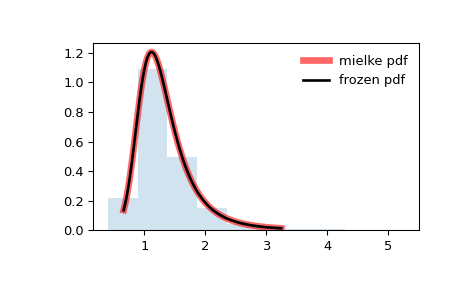scipy.stats.mielke¶
-
scipy.stats.mielke= <scipy.stats._continuous_distns.mielke_gen object>[source]¶ A Mielke Beta-Kappa / Dagum continuous random variable.
As an instance of the
rv_continuousclass,mielkeobject inherits from it a collection of generic methods (see below for the full list), and completes them with details specific for this particular distribution.Notes
The probability density function for
mielkeis:\[f(x, k, s) = \frac{k x^{k-1}}{(1+x^s)^{1+k/s}}\]for \(x > 0\) and \(k, s > 0\). The distribution is sometimes called Dagum distribution ([2]). It was already defined in [3], called a Burr Type III distribution (
burrwith parametersc=sandd=k/s).mielketakeskandsas shape parameters.The probability density above is defined in the “standardized” form. To shift and/or scale the distribution use the
locandscaleparameters. Specifically,mielke.pdf(x, k, s, loc, scale)is identically equivalent tomielke.pdf(y, k, s) / scalewithy = (x - loc) / scale. Note that shifting the location of a distribution does not make it a “noncentral” distribution; noncentral generalizations of some distributions are available in separate classes.References
- 1
Mielke, P.W., 1973 “Another Family of Distributions for Describing and Analyzing Precipitation Data.” J. Appl. Meteor., 12, 275-280
- 2
Dagum, C., 1977 “A new model for personal income distribution.” Economie Appliquee, 33, 327-367.
- 3
Burr, I. W. “Cumulative frequency functions”, Annals of Mathematical Statistics, 13(2), pp 215-232 (1942).
Examples
>>> from scipy.stats import mielke >>> import matplotlib.pyplot as plt >>> fig, ax = plt.subplots(1, 1)
Calculate the first four moments:
>>> k, s = 10.4, 4.6 >>> mean, var, skew, kurt = mielke.stats(k, s, moments='mvsk')
Display the probability density function (
pdf):>>> x = np.linspace(mielke.ppf(0.01, k, s), ... mielke.ppf(0.99, k, s), 100) >>> ax.plot(x, mielke.pdf(x, k, s), ... 'r-', lw=5, alpha=0.6, label='mielke pdf')
Alternatively, the distribution object can be called (as a function) to fix the shape, location and scale parameters. This returns a “frozen” RV object holding the given parameters fixed.
Freeze the distribution and display the frozen
pdf:>>> rv = mielke(k, s) >>> ax.plot(x, rv.pdf(x), 'k-', lw=2, label='frozen pdf')
Check accuracy of
cdfandppf:>>> vals = mielke.ppf([0.001, 0.5, 0.999], k, s) >>> np.allclose([0.001, 0.5, 0.999], mielke.cdf(vals, k, s)) True
Generate random numbers:
>>> r = mielke.rvs(k, s, size=1000)
And compare the histogram:
>>> ax.hist(r, density=True, histtype='stepfilled', alpha=0.2) >>> ax.legend(loc='best', frameon=False) >>> plt.show()

Methods
rvs(k, s, loc=0, scale=1, size=1, random_state=None)
Random variates.
pdf(x, k, s, loc=0, scale=1)
Probability density function.
logpdf(x, k, s, loc=0, scale=1)
Log of the probability density function.
cdf(x, k, s, loc=0, scale=1)
Cumulative distribution function.
logcdf(x, k, s, loc=0, scale=1)
Log of the cumulative distribution function.
sf(x, k, s, loc=0, scale=1)
Survival function (also defined as
1 - cdf, but sf is sometimes more accurate).logsf(x, k, s, loc=0, scale=1)
Log of the survival function.
ppf(q, k, s, loc=0, scale=1)
Percent point function (inverse of
cdf— percentiles).isf(q, k, s, loc=0, scale=1)
Inverse survival function (inverse of
sf).moment(n, k, s, loc=0, scale=1)
Non-central moment of order n
stats(k, s, loc=0, scale=1, moments=’mv’)
Mean(‘m’), variance(‘v’), skew(‘s’), and/or kurtosis(‘k’).
entropy(k, s, loc=0, scale=1)
(Differential) entropy of the RV.
fit(data)
Parameter estimates for generic data. See scipy.stats.rv_continuous.fit for detailed documentation of the keyword arguments.
expect(func, args=(k, s), loc=0, scale=1, lb=None, ub=None, conditional=False, **kwds)
Expected value of a function (of one argument) with respect to the distribution.
median(k, s, loc=0, scale=1)
Median of the distribution.
mean(k, s, loc=0, scale=1)
Mean of the distribution.
var(k, s, loc=0, scale=1)
Variance of the distribution.
std(k, s, loc=0, scale=1)
Standard deviation of the distribution.
interval(alpha, k, s, loc=0, scale=1)
Endpoints of the range that contains fraction alpha [0, 1] of the distribution